Sydney Real Tennis Club reopens for play after 20 years without a court
Court becomes fourth to open worldwide in the last five years
The first ball has been struck on the brand new Sydney court last weekend, marking the opening of the 46th active jeu à dedans court in the world.1 It becomes the fourth new court to open in the 2020s decade, and the third in the same timespan to be relocated from a previously closed court following Washington and Bordeaux. It is also the first new tennis court to open in Australia in 26 years, going back to the opening of Romsey just before the turn of the millenium.
The first real tennis court in Sydney was built in 1997 at Macquarie University under the supervision of Wayne Davies, but only lasted eight years before it closed. Since then, the Sydney Real Tennis Club has been kept alive by a small group of keen players touring through Victoria and Tasmania each year while they searched for a new site. After several false starts, an opportunity arose to build a new court at the Cheltenham Recreation Club (CRC) in 2018, less than 10 minutes down the road from the original court.
The CRC has a history dating back to 1912 and features lawn tennis, bowls and croquet sections alongside dining and function spaces. The real tennis court has been built adjacent and connected to the existing clubhouse. Planning consent for the new court was approved by the local council in 2021, allowing fundraising to commence in earnest. The task was made easier upon the receipt of a matching grant by the New South Wales government in November 2022 of AU$1.4 million, alongside AU$0.8 million already raised from private donors. The ground was broken in June 2023, but construction did not begin until early 2024.
The court is built on the side of a slope, with the main entrance of the CRC and the croquet greens being on the mezzanine level of the real tennis court. A unique design element of the court is that the grille and tambour walls have been built as external walls, rather than internal walls in front of the back wall and main walls respectively. This has resulted in the unusual feature of being able to see through the grille out to the train line beyond. As has been the case in several new build courts over the past 20 years, Sydney joins Bordeaux, Westwood, Cambridge Blue, Romsey and the Oratory2 in having large windows running along the full with along the high service wall, allowing excellent views of the court from the mezzanine gallery. Below, a glass partition separates the dedicated dedans viewing area from the larger clubrooms and pro shop, in a manner similar to Lord’s or Melbourne.
Chris Ronaldson will serve as the inaugural head professional of the court, and served as a consultant on the court during the design phase. “It’s a fairly standard court in terms of sizing with a fairly standard tambour,” said Ronaldson. “The penthouse is a degree or two steeper than the average — that was down to me. The ledges of the galleries are very slightly higher, as is the dedans, but not the grille. The last gallery has been pulled in very slightly by eight inches or so.”
The court therefore follows Westwood in having a smaller openings than average, though Ronaldson insists that it will not be as extreme as the recent US Open venue. “Westwood was designed like [Sydney], they were supposed to put the dedans ledge up by two inches, but it went up by three inches.”
Now that play has commenced, Ronaldson has been able to build his first impressions on how the court is playing. “The floor is a little bit slow, the walls are a bit grabby, which from a pro’s perspective means that it is going to wear out the balls. But we’re used to it already, and already it starts to change character. Courts speed up gradually over the first little bit. It’s too early to say how much it’s going to speed up by and if it’s not sped up enough, then in six months time they’ll re-grind the floor.”
Ronaldson and Maggie Henderson-Tew will serve the balance of the month in Sydney before returning to the UK. At that point, Alexander Marino-Hume will take over, having moved from the apprentice role at Lord’s. “Lord’ is a very busy club where we strive to get maximum court usage and so translating that over to a new court in Sydney will hopefully stand me in good stead for building up an active playing membership based there,” said Marino-Hume. “I’ve obviously also spent a year and a half under Chris Bray and Chris Swallow both of whom have many years experience of running successful clubs, so I have learned a good blueprint!”
Marino-Hume continued, “Sydney’s gonna be a great experience for me as a professional, throwing me in at the deep end but I hope it is a successful real tennis club, continuing from the strong start that the club will have under Chris Ronaldson and Maggie [Henderson-Tew]. I’m looking forward to finding great players within Sydney to bring into the game or bring back to the game, travelling to see the guys in Melbourne to hit with and playing in all the different domestic tournaments in Australia.”
Marino-Hume has the unenviable challenge of bringing in a lot of new players to the game to bring the club to a point of financial sustainability. Nevertheless, he remains optimistic about the task ahead. “Real tennis players themselves often are the best advocates of our fantastic game so word-of-mouth is going to be hugely important, conveying the wonderful nuances we all enjoy every time we play,” he said. “We hope to tap into local schools and universities, as having a thriving junior section is very important for any club, and we hope that putting the word out on social media and in the national press will spread the word far and wide for people to come and play at the brand-new court.
“Measuring success of any real tennis club can often be done by looking at its booking sheet. But that only tells half the story. If Sydney Real Tennis Club can create a welcoming atmosphere where people feel part of a special community who all appreciate this niche and wonderful game, and who want to give their time and efforts to its benefit, then that will give me as good an indication as any of the success of the club both at the present and for the future.”
Over the initial few months, Marino-Hume will be assisted by Archie Campbell, who recently completed an internship at Radley but is not yet a fully qualified professional. The search will then continue for a second full time professional.
The official opening tournaments have started this weekend with the Founder’s Cup for the donors and supporters who have financially contributed to the project. This will be followed by the friendly doubles and the Easter Bilby tournaments, giving interstate and international visitors the opportunity to experience the court. Competitive play has already commenced with a tour match against the US Jesters, being the first matches played on the court.
It will be a busy year for the new court. The first high level competitive tournament at the club is expected to be the New South Wales Open — which will also include a women’s division — in August, followed by the Australian Amateur Singles in October. The club is expected to host touring teams from the interstate clubs in Australia, and will host the Danby Trophy (for over 70’s) and Munoz Trophy (for over 80’s) team tournaments for the World Masters in March 2026.
The Sydney Real Tennis Club is now accepting new memberships. Prospective and touring players can book courts or enquire about memberships via email at pros@sydneyrealtennis.com.au, or by calling +61 466 591 907. It can be accessed from the Sydney CBD via the T9 train, either directly or connecting via the M1 metro at Epping, or alternatively is a direct drive over the Sydney Harbour Bridge and the M1 and M2 freeways.
Below is a transcript of an interview with the inaugural head professional, Chris Ronaldson. The questions and responses have been lightly edited for clarity.
What was the impetus for building the original Macquarie University court and why did it not succeed?
I know Wayne Davies was heavily involved. He wanted to invest in a court and, being Australian, he wanted to go back to Australia. But the site they found was at Macquarie University and it turned out not to be a very good fit, simply because the court was embedded in the heart of the university, which made it quite difficult to get to for non-university players. But more importantly, it proved to be difficult to interest Macquarie University students in playing, as many of them come from backgrounds and places where racquets sports are less often played. Eventually, the university wanted the court’s space for use as a gymnasium or a martial arts hall. They gave the Sydney Real Tennis Club some money back and offered a different site, but the change of site on the campus did not happen; the deal fell apart.
What was that court like as a building, as a court?
It was fine. Like all new buildings, it had its issues at the start, as the floor was too rough. Though by the time I got to play a couple of years later, it was fine.
Since that court closed, the Sydney club has still managed to sustain themselves as a peripatetic club.
Yes. Throughout that period, they’ve been trying to find somewhere else to build. And they thought they had a very promising lead at White City, but in the end it fell through. So this is the fruition of 20 years of effort. I know it’s been a long, long slog.
But then eventually the agreement came with Cheltenham. Can you tell me a bit about what the agreement was?
It won’t be authoritative but it was something like this. Michael Fitzgerald, who was the president of [the real tennis] club, happened to be playing lawn tennis at the Cheltenham Recreation Club (CRC), because Cheltenham is a tennis, croquet and bowls club, or was then. He could see that they had space, and said, “Look, do you guys want a real tennis court?” And the Cheltenham club, which was struggling for revenue and members, said, “well, why not?” And that’s how it started. So, there’s been a very complicated set of agreements between Cheltenham and Sydney, where originally it was going to be another section of the CRC, like bowls, lawn tennis and croquet. But in the end we have our own management [for real tennis].
Did Cheltenham just supply the land, or did they supply some funding to it as well?
Quite the reverse. They supplied the land, but they wanted funding compensation. They’re struggling really badly financially, and they’re not able yet to see that this is going to be a moneymaker for them, bringing in many new members, who will use more than the real tennis court, and will spend money at the bar and in the café. We have also introduced the idea of adding padel and pickleball, which will expand the sports on offer to different groups of players.
So how much did the court end up costing, and where did the money come from for that?
Well, I think the court has cost something like AU$3 million — more or less £1.5 million. They were fundraising for years and years and years, but the bulk of the money has come from the New South Wales government sports group that was prepared to give a triple-your-money grant; “for every dollar you put in, we’ll put in two.” And at that stage, Sydney had raised AU$700,000 and so the New South Wales government put in AU$1.4 million. That suddenly turned the money from being a quarter of the amount to over two thirds, which really propelled everything forwards.
So going on to the court itself, how has it been designed? What was the philosophy behind designing this court?
It’s a mixture, really, of innovation by Sav Cremona, who was the draftsman who’s put the plan together. I don’t know if you’ve seen pictures, but it doesn’t have a back wall behind the grille — you’re looking straight out of the grille, which is a window here, onto the train line, but through greenery, so you don’t really see the trains go past. The back penthouse is open to the outside on the underside, and cut-away, so that’s an unusual design feature. It’s a fairly standard court in terms of sizing, with a fairly regular tambour. The penthouse is a degree or two steeper than the average — that was down to me, as I was asked my opinion. The galleries are very slightly higher — the ledges — as is the dedans, but not the grille, with the last gallery has been pulled in very slightly by eight inches or so. Again, that was my suggestion.
Is it as extreme as Westwood or not quite as far?
No. Westwood was designed like this, but they were supposed to put the dedans ledge up by two inches, but it went up by three inches, so it looks more like a postbox slit now, doesn’t it? So, it’s not as bad as Westwood — that was just a building fault, never mind the timber building fault they had. But the one big difference between here and Westwood is that I’ve managed to put the service line in an extra foot further forwards [on the hazard side towards the net], so it's marginally less likely to get a hazard chase.
What angle is the tambour at? Do you get balls going into the hazards off the tambour? Or do they go into the back corner?
They will do neither, as because I pushed that service line forward it doesn’t get as far as the hazards usually. You can do it by pummeling it from the back-hand side — a square one high up — but not normally. Very few hazards here.
If I were to arrive at the club, what would I see first? What would I experience? Give me a tour.
You would arrive at the front door of the Cheltenham Recreation Club, and if you go straight on and upstairs, you’ll get into their café, Molly’s. But if you didn’t do that — if you turned right — you’d get into the real tennis court complex, as it were, and you’d be on a mezzanine level. If you walked around the side of the court, you’d find yourself looking down the court from the window, like at Radley, and that's what the tourists will see first. [The viewing windows] are not quite floor-to-ceiling, but they are from two feet up. That room is incomplete [at the moment], so is a rather bleak box, but that will change soon.
If you then take the stairs downstairs, you’ll get into the royal dedans behind the main dedans, which is a club room, set up with a couple of settees and a dining table, and a pro shop in the far corner. What is very good is that, although these rooms are underground, there is daylight through spaces cut into the ceiling. Apart from that, it’s fairly standard court.
What’s the lighting like on the court?
I haven’t had any negative comments, it's LED lights. Who knows how quickly the lights will fall off in performance, but they're fine.
Do you get any natural light in there at all?
There is some natural light, and there’s a facility if you want to have only half the lights on. But because we don’t have a separate lighting charge, I don’t think anyone will use that, I think they’ll just turn the lights off or full on.
There are some courts where the natural light can get glary from certain angles at certain times of day, is that an issue?
We are going to get sunspots at certain times. Now, we’ve had a lot of sunny days recently, and the sun has never caused a problem, but at different times of the year when the sun is at a different angle, it might do. We don’t know yet.
So you’ve started play on the court now.
Yup, the first day was last Saturday.
What are your first impressions on how it’s playing?
At the moment, it’s slow. The floor is a little bit slow; the walls are a bit grabby, which from a pro’s perspective means they’re going to wear out the balls. It’ll mean sewing balls a lot more. But we’re used to it already, and already it starts to change character — as courts do, they change character. They speed up gradually over the first little bit.
I guess it’s too early to say how much it’s going to speed up by then?
Yes, and there’s two things we might do. If it doesn’t speed up enough, then in six months time or so, they’ll re-grind the floor, or do something to make it faster, in the same way that if it’s deemed unsatisfactory [due to the pale colour], they’ll stain the penthouse roofs. You know how Washington is — if you’re marking a railroad, it’s sometimes hard to see exactly where the bounce is. We haven’t had that issue here, but if we do, we might have to alter the colour.
If the walls are grabby is it just the main wall that is grabby or is it cutting down off the back as well?
They’re all quite grabby, so it will cut down, except that when you really heavily cut the ball, a lot of the spin dissipates on the floor.
Serving, is there any particular thing that has become popular in the first few days?
We’ve had 12 hours booked today, but 10 of those have been lessons — there’s a lot of beginners here. I’ve had the interns on the court, and it's going to be a server’s court because of the steep penthouse. Which is why I did it like that. Have I talked to you about my philosophy on courts?
Bits and pieces, but…
It’s this: that essentially my two big worries for the game are, first of all, that players will decide that it’s best to be at the hazard end. The ball comes down and it’s going to set chase five, and they just stay up. They’re just not interested in it. They’re just letting it go to set the chase: “I’d rather be at the hazard end.” That would be not much fun to play and not much fun to watch. Everyone’s trying to get down the hazard end, or just smashing the ball into the hazards or something like that. That’s one of my worries. You’ve got to make the service end attractive. The corollary of that is that if the service end is too attractive, then people just go second gallery, second gallery, change ends. That’s not fun to play, and it’s boring to watch too. That’s why I raised the gallery ledges very slightly. Pulled the last gallery in just eight inches, just to make it slightly harder to hit the openings except the grille. Tweaking the penthouse is the same thing. Obviously the flatter the penthouse is, the easier it is to return serve and the harder it is to serve.
With the height of the building, is a high service a possibility, or do you have to get a lot of side on those?
The building here is not as high as it could be. It’s higher than Radley, for instance. It’s probably a couple of feet higher than Radley, maybe a meter higher, but it’s not as high as any of the other Australian courts.
Yeah, I guess those are all pretty high though. You think of a... I mean, Ballarat’s got a fair bit of space to it, Melbourne’s got a fair bit of space to it…
Yeah, and so has Hobart too. So you can do great towering giraffes and high serves. So of the high service here, the high sidewall serve, the one you do, is good, but the giraffe is difficult to get back going.
Is it taking a railroad?
Yeah. And that again is a function of that grabby back wall.
So you’ve now got a whole bunch of both Sydney members who all of a sudden have a court they can play on, and a bunch of Cheltenham members who are a bit like, what’s this new thing in our club…
No, in the main, they’re not Cheltenham members, the ones who are coming in. They are friends of the existing members. They’ve been telling their friends for at least the past 10 years, “We’ve got this court coming, support us and sign up,” and they’re all coming in, having a go. I've rung everyone on the contact list, so that’s why we’ve got so many lessons this week. We having to cram them in at the moment because we’ve got the big opening tournament starting, in which we’ve got eleven days of tournaments and celebrations, so I’m trying to pack as many of these beginners in before then.
So roughly how many existing club members have come across and new friends thereof have given it a go, or are likely to give it a go between now and the opening? What's the core membership to be starting off, I guess is my question, numbers-wise?
They’ve probably had about 60 people on their list, but a lot of those are interstaters and people who’ve just signed up to be supportive. So we’re trying to reel it in and find out which ones are really keen. I think in a sports-loving city like this, I’m going to be amazed if there’s not 150 members by this time next year.
Can you talk a bit about what that opening tournament’s going to entail. Who is visiting, what the format’s going to be, etc?
Well, there are three tournaments, all doubles. The first two days of the event are going to be spent holding a Founders Tournament. Those people who gave — I think it’s over AU$5,000 — they are all going to play a special two-day tournament on Friday and Saturday next week. And then there’s going to be what we call a Friendly Doubles Tournament from the 13th to the 16th, which is a four-day repechage tournament. And then the last five days are left for the Bilby Tournament, named after the Australian equivalent of the Easter Bunny, and that’s a round robin group format, with knockouts at the end of it. All doubles, all handicapped.
Right. I guess there's going to be some players who will improve much faster than their handicap in that time then.
Well, except none of the people who are starting this week are going to be in that tournament. The entrance to that tournament closed a month ago.
And then moving on past that opening tournament, how much longer are you staying in Sydney, and what's the plan to be staffing the club going forward?
Good question. Maggie [Henderson-Tew] and I leave on the 27th of April to get back to Radley. Alex Marino-Hume is the appointed professional, he's been here for 10 days. We've got a couple of rogue interns here, who have been fantastic. Archie [Campbell] — you know of course from Radley — he's going to be staying on for an extra month and we hope that by that time they’ll have found someone else to take over the brunt of the assistant pro job. Alex Marino-Hume only applied to the assistant job, but he's going to be the lead professional. It’s particularly good for him, as he was number three at Lord’s, he's now number one here.
It probably would be a two pro club if it was in the UK, for its size.
Yeah, at least. Yeah, two to two and a half I guess.
And so what does the calendar then look like for the remainder of the year?
I'm not the one to talk to you about that and I don't really know all the details but I know they're going to be running a New South Wales Open here. I know there will be pennants and there’ll be weekend competitions. And there’ll be interstate and international matches. For many years now Sydney’s played friendly matches against Hobart, Ballarat and Melbourne. And they’re looking forward to being able to invite these clubs over.
I guess it’s always the case that the newest court in the world is always the hot travel destination for real tennis players.
And fair enough, I think because it’s in Australia and the weather we have here, it’s always going to be a destination for gap year students. For Gappies who’ve played the game already, it’s a lovely place to come to and spend three months in the middle of an English winter.
To some extent that’s what Melbourne’s done as well in the past hasn’t it?
Agreed.
How are the ball stocks?
Because we were very delayed, I made four complete sets of 72 balls. And we ordered in 130 rackets and we have strung 70 between us. So we’re ahead on balls and rackets and behind on most other things.
My job here is just to build up membership and try to get as many people to have lessons as possible. I’ve got a lesson in 20 minutes’ time.
Right. I shall let you go for your 10 minute mark and your lesson. Thanks so much for your time and we’ll see you back in Radley soon.
I hope you’ll come out and visit this court very soon.
I indeed hope to.
Not including Romsey, Greentree or Fairlawne, which do not see active play, and not including Falkland Palace which is a jeu quarré design, and not including Pau which is a trinquet despite being the dimensions of a standard real tennis court.
Melbourne and Queen’s East only have partial width glass viewing areas, while Radley’s glass viewing area is only half the height of the room. Newport and Romsey have glass viewing areas at the hazard end, and Prested and Romsey have glass viewing areas below the height of the penthouse. Middlesex’s glass viewing areas is currently closed off. The original Sydney court at Macquarie University also had glass viewing at the service end.



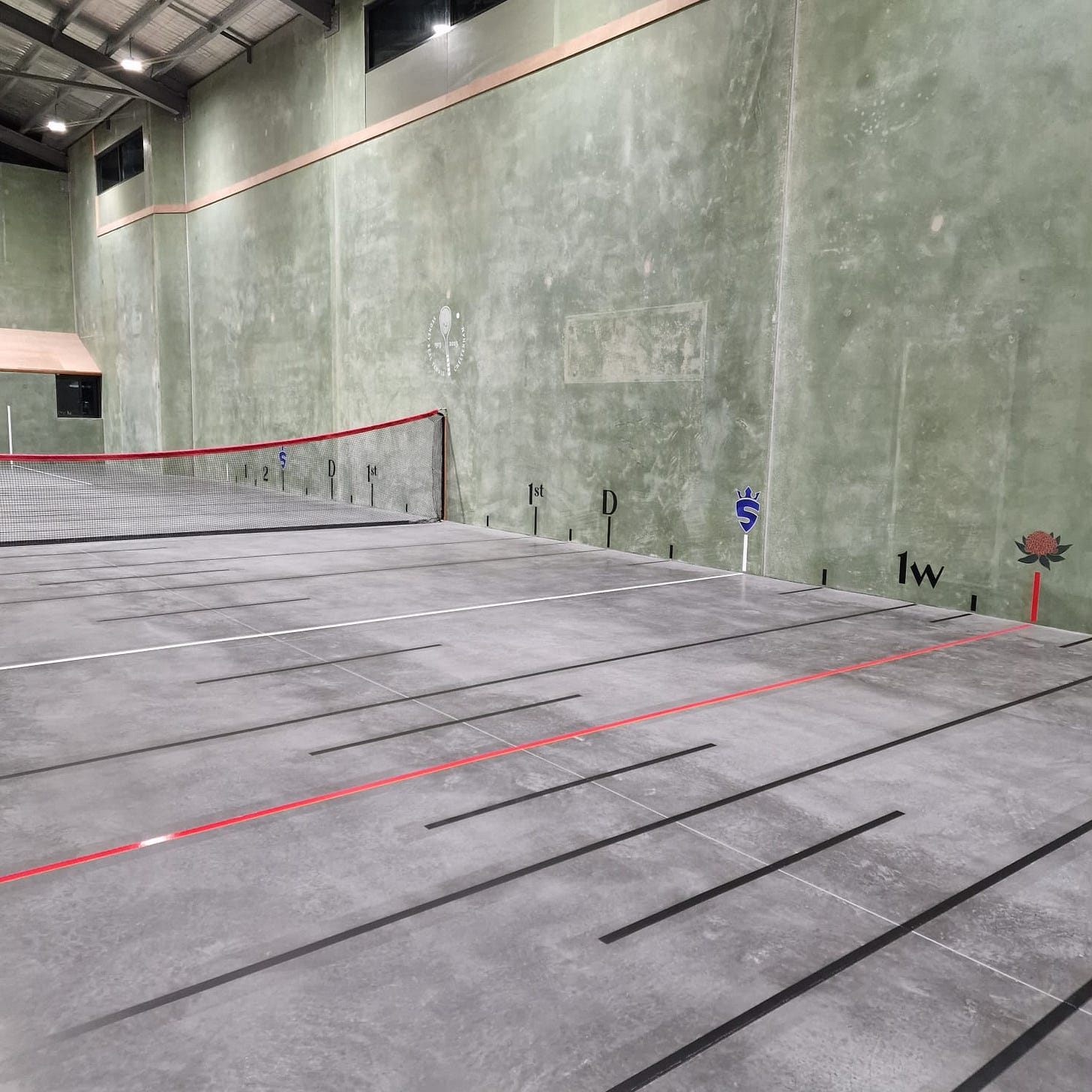
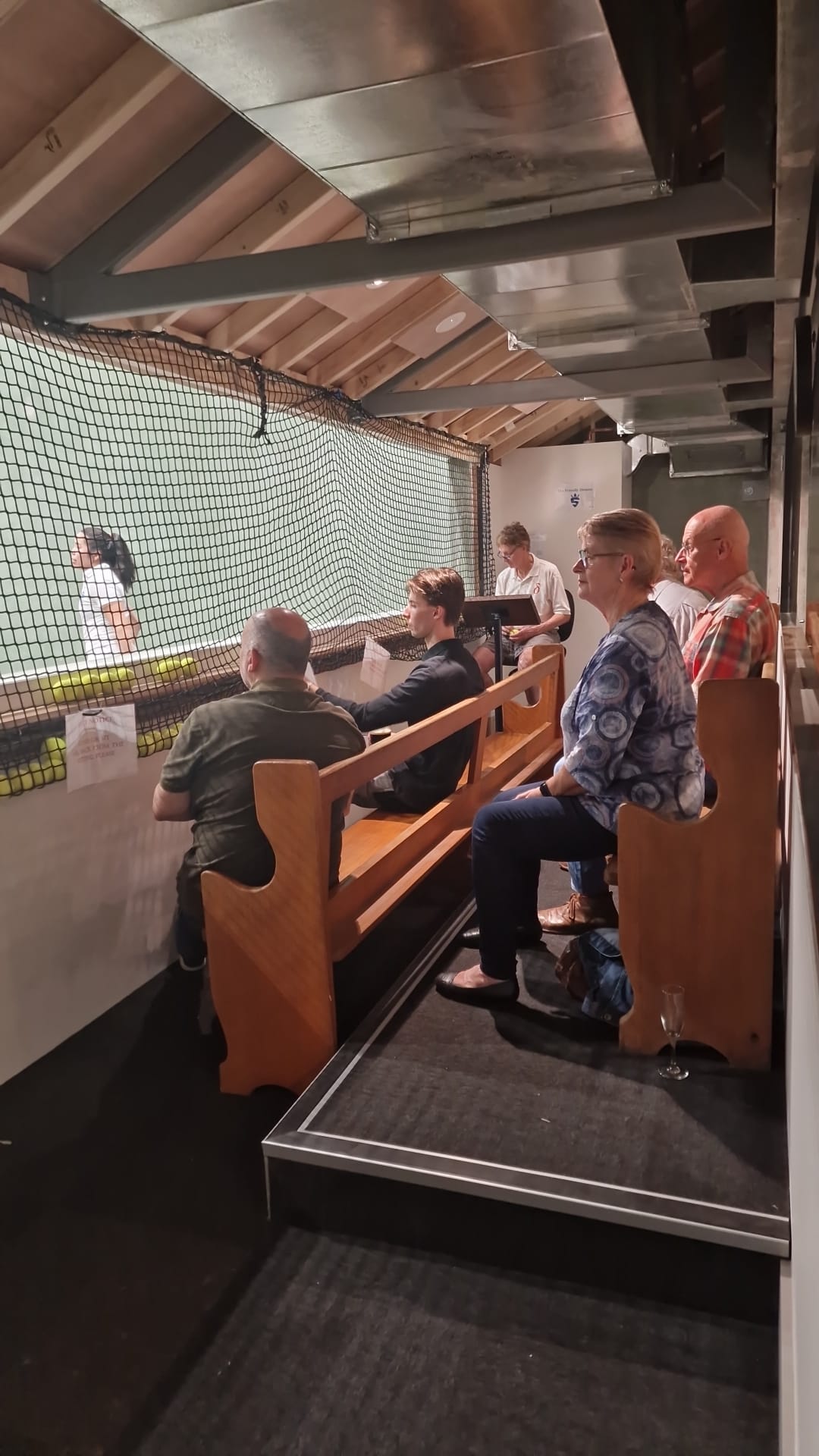
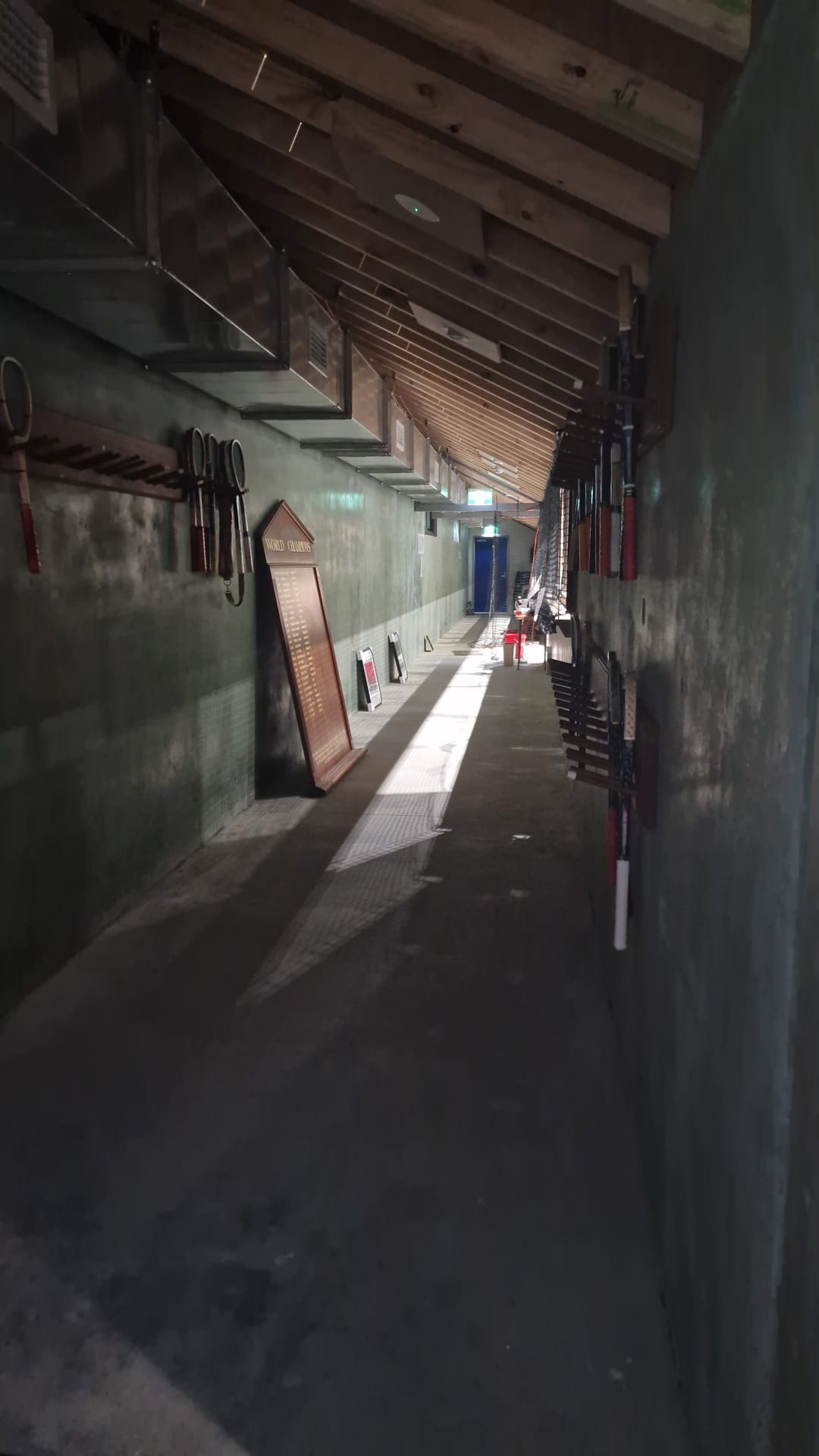
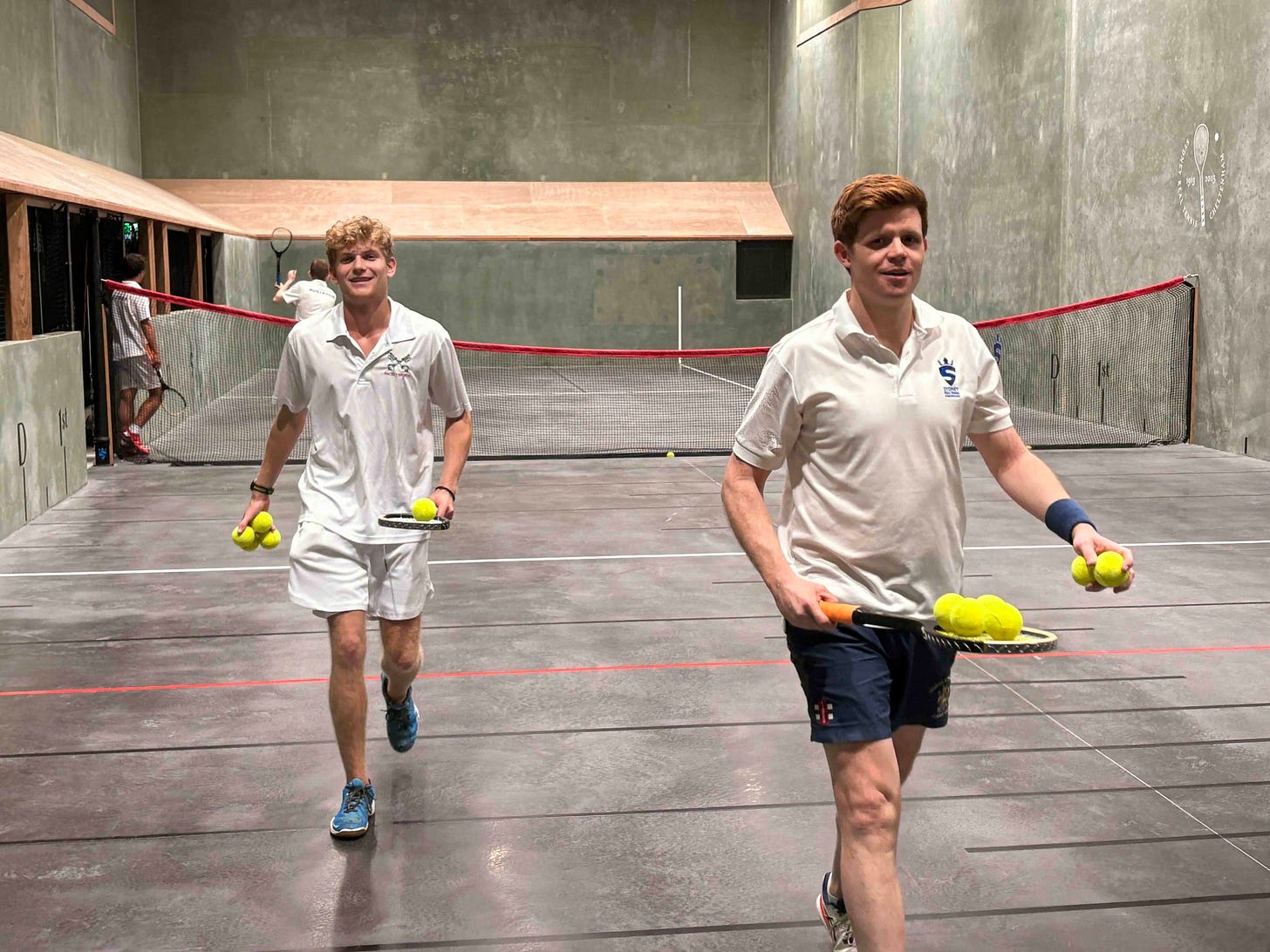
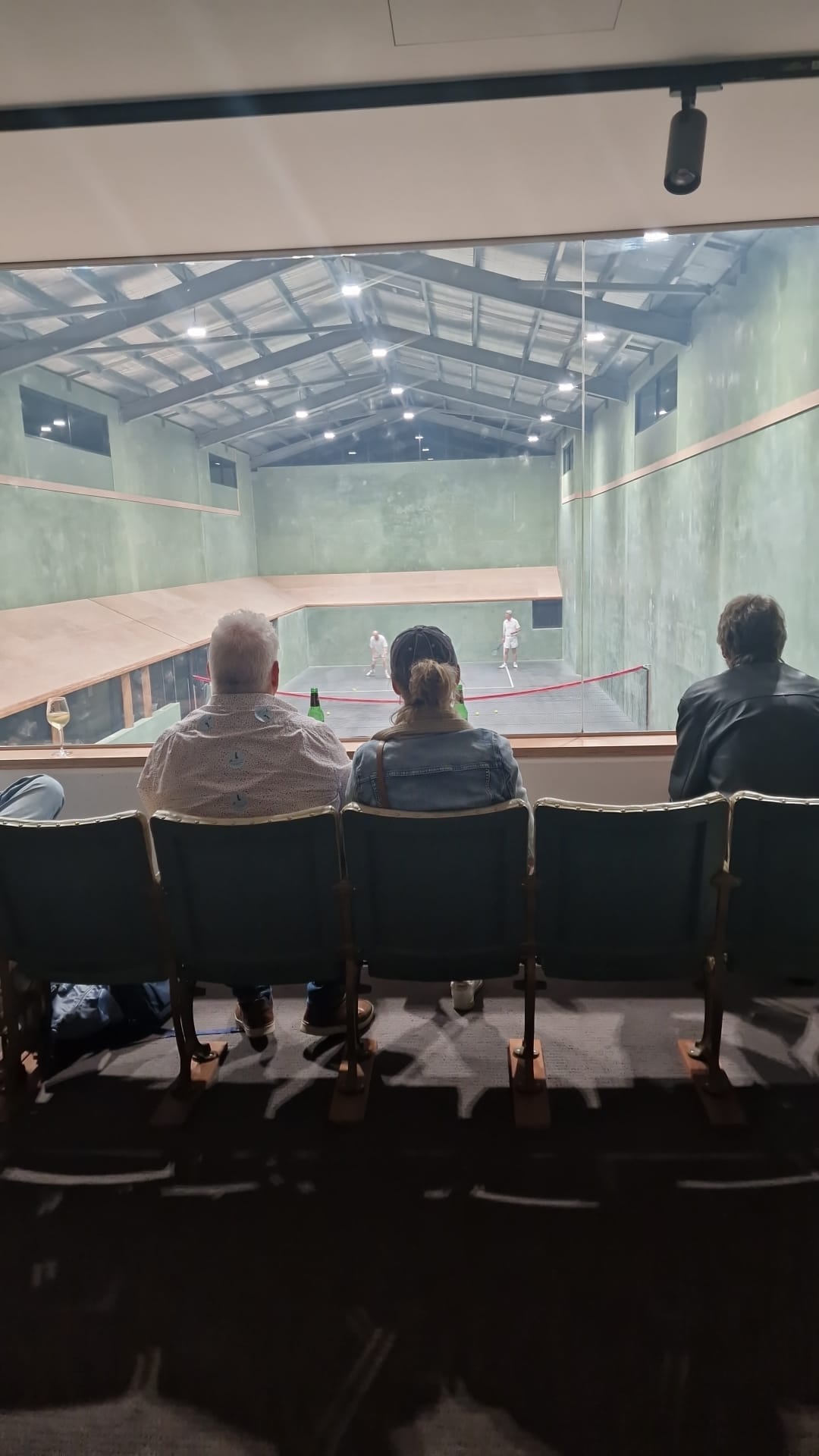
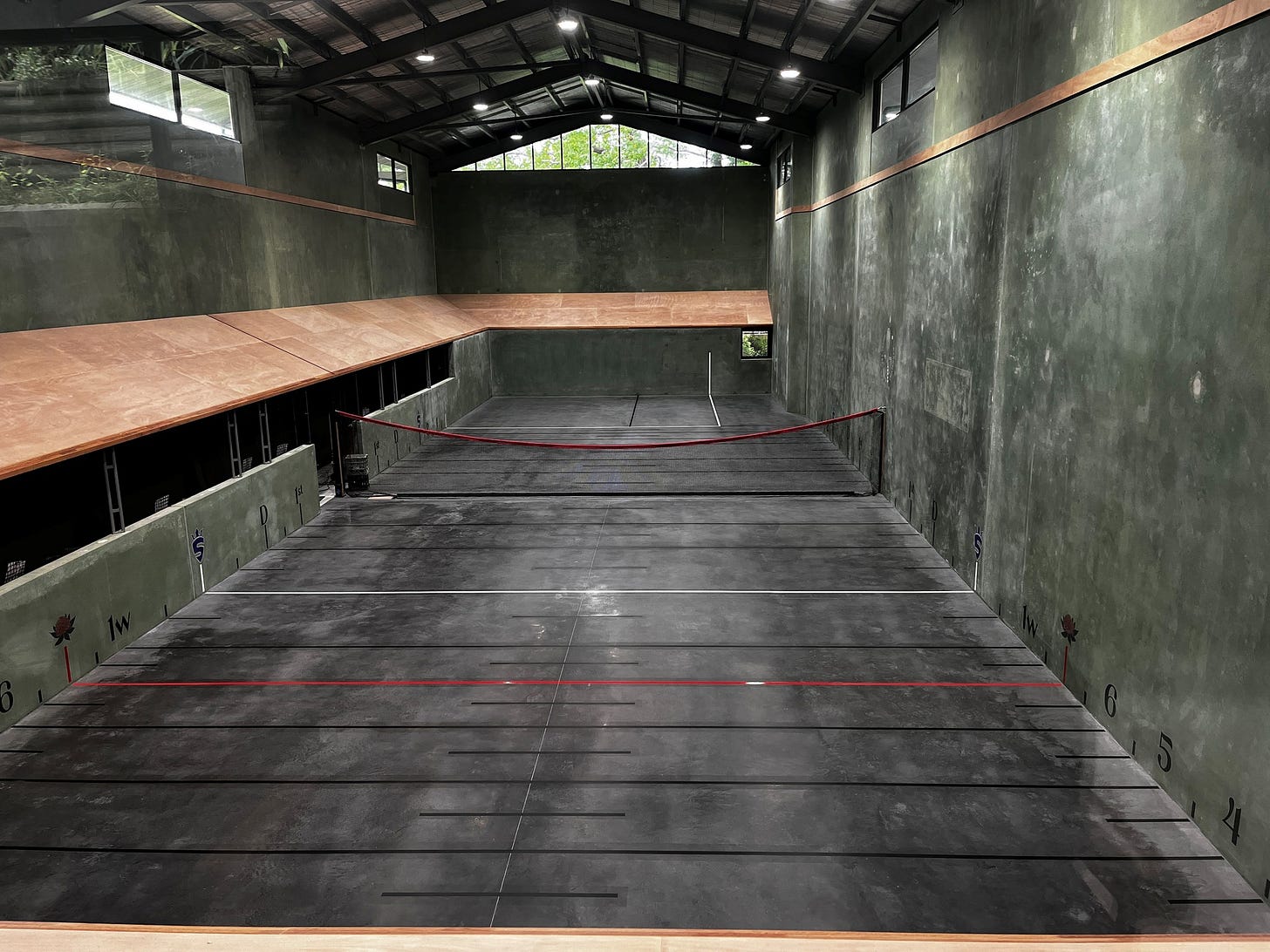
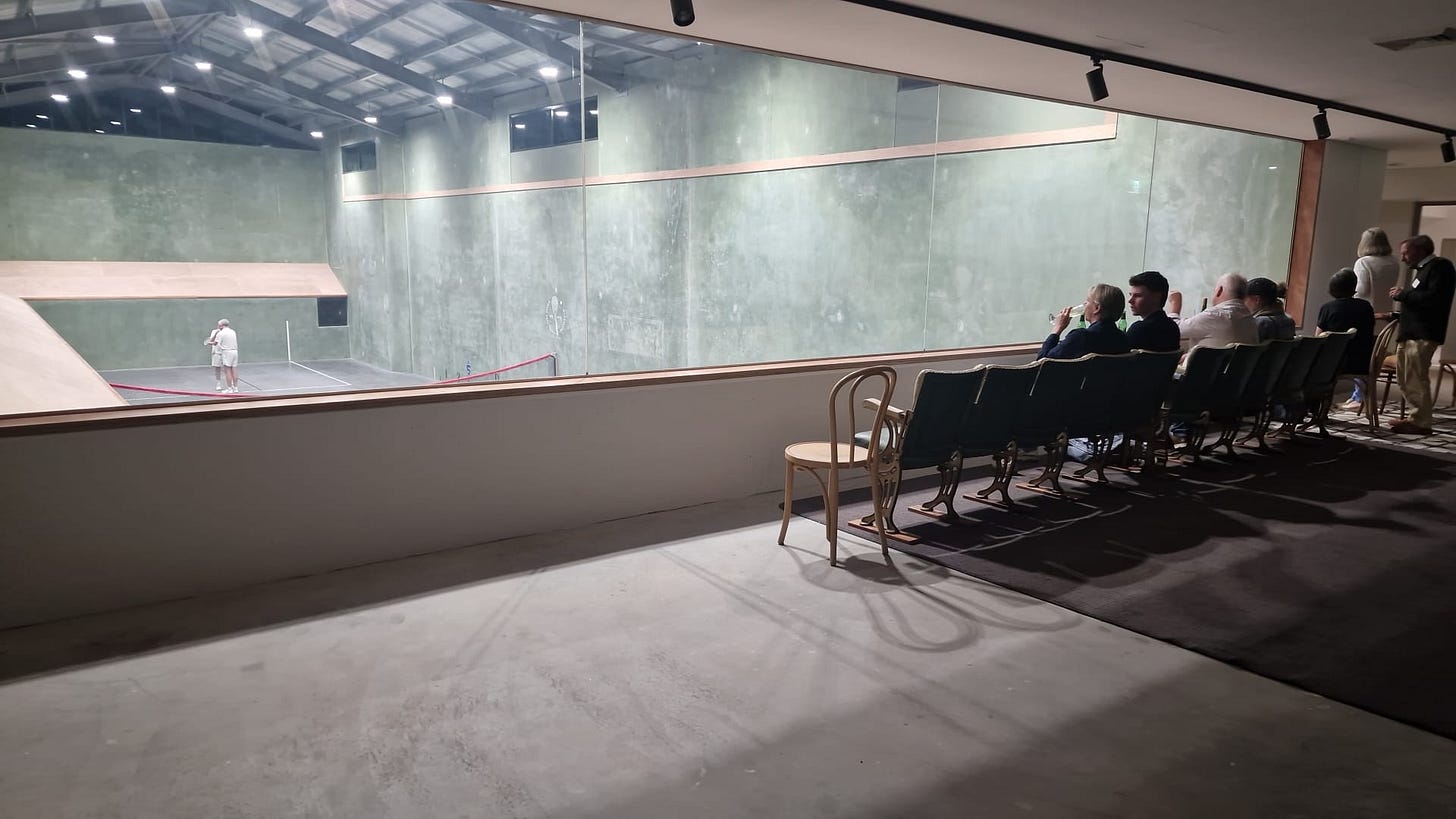
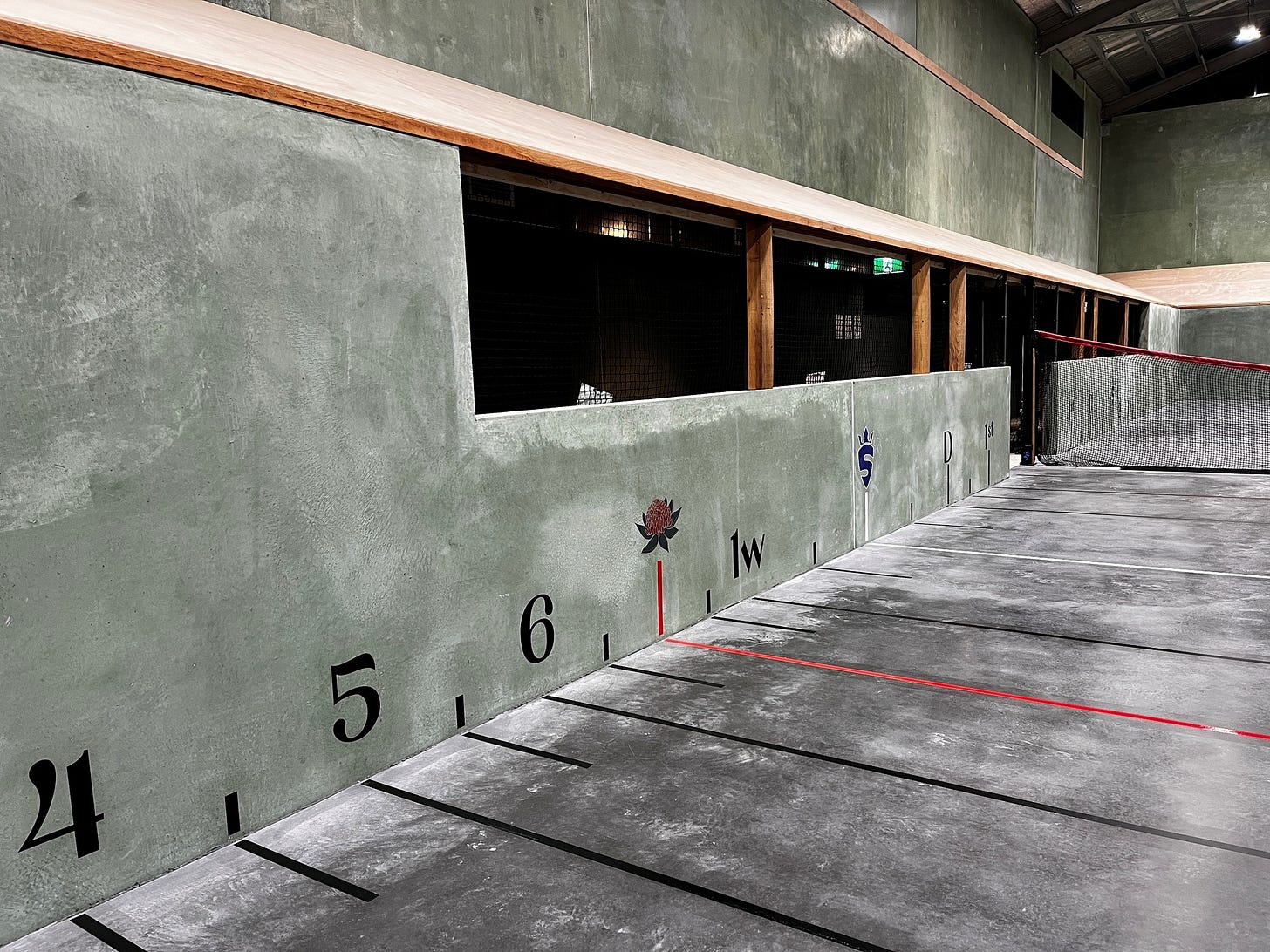
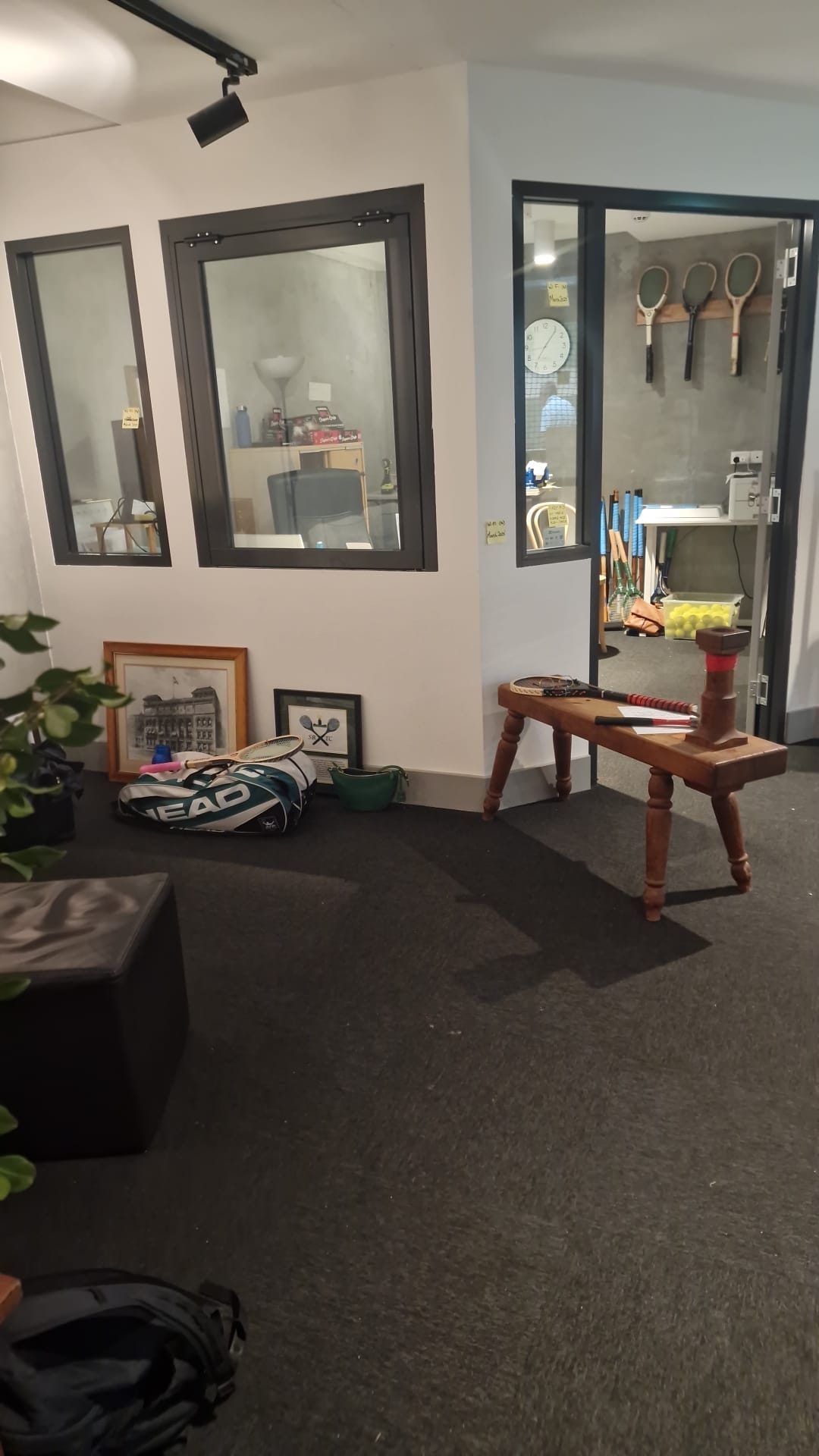
Terrific reporting BG